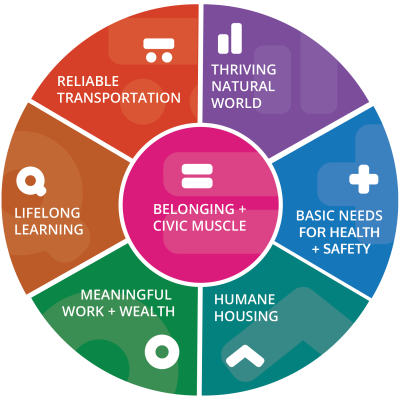The Federal Plan for Equitable Long-Term Recovery and Resilience (Federal Plan for ELTRR) leverages the Vital Conditions for Health and Well-Being as the guiding framework. The vital conditions identify the factors that people depend on to reach their full potential, organized into 7 categories.
The vital conditions framework provides an actionable organizing structure to build connections and alignment across federal agencies and sectors. The framework can support efforts to achieve the transformative change needed to build a strengths-based and community-driven federal response.

“Now more than ever, we must work to ensure everyone has access to nutritious foods that support good health. This is a complex effort that can only be achieved by addressing the systemic issues that contribute to food insecurity and poor nutrition, including inequities in housing, education, the workforce, and more. Therefore, we need a collaborative, government-wide action led by a shared vision: an America where all can thrive.”
What are the vital conditions?
The 7 vital conditions detailed in the Vital Conditions for Health and Well-Being Framework are required for people and communities to reach their full potential. The Federal Plan for ELTRR is centered on these 7 vital conditions:

“I think we can all agree that every one of us has a stake in the health of our environment, the strength of our economy, the well-being of our communities, and the legacy we leave to the next generation.”
The vital conditions framework provides an actionable organizing structure to build connections and alignment across federal agencies and sectors. The framework can support efforts to achieve the transformative change needed to create a comprehensive, asset-based, community-centric federal response.
The vital conditions framework has roots in the community and is centered on the element of “belonging and civic muscle.” That’s because civic engagement is key to building community capacity and because local, self-driven, tailored solutions are critical to addressing local needs — and ultimately to fostering community leadership to build an equitable, thriving future.
The vital conditions framework presents an actionable, asset-based approach to address and advance beyond social determinants of health and inequities. Notably, the framework identifies the core elements needed to create a thriving community rather than measures of productivity or descriptions of vulnerabilities or negative determinants in a community.
Finally, the vital conditions resonate with all sectors in a community and naturally demonstrate the central role of sectors that address housing, employment, transportation, climate sustainability, economic development, health, and more to facilitate thriving.
Literature connecting resilience and the vital conditions
The Vital Conditions for Health and Well-Being framework directly aligns with core tenets of resilience identified in current literature and practice. Guided by this framework, the Federal Plan for ELTRR seeks to build the capacity of individuals, communities, and systems in order to achieve greater resilience across all aspects of life.

“Community resilience is a complex, multi-dimensional problem that relies on social sciences, engineering, health sciences, earth sciences, and other disciplines to improve the way communities prepare for, resist, respond to, and recover from disruptive events. Community resilience will be advanced by establishing a more comprehensive, integrated suite of metrics across the subsystems that remain meaningful in the absence of a disaster. Understanding how the performance of these subsystems impacts resilience can improve planning, policy formation, and decision-making for hazards as well as chronic stressors.”
The concept of resilience is widely used at the individual, community, and systems levels, yet there is no single conceptual or operational definition that applies across contexts, institutions, countries, and use cases. Still, it is widely accepted that resilience is not a process, a single outcome measure, or a static state of being. Instead, resilience is a dynamic and demonstrable capacity that includes a proactive, strengths-based action to reduce risk.
Literature supports the idea that it’s best to build resilience at a local level and through investment in ongoing or steady-state systems that support the full range of needs across the community and lifespan. Further, research supports the importance of ensuring community members are equitably included and have real power in decisions that affect the development of long-term resilience.







